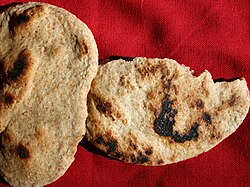Roti pipih
Roti datar adalah sebuah roti yang dibuat dengan tepung, air dan garam, dan kemudian dibentuk menjadi adonan datar. Beberapa roti datar dibuat tanpa ragi meskipun beberapa menggunakan ragi, seperti roti pita.
| Roti datar | |
|---|---|
 Roti datar buatan rumah | |
| Jenis | Roti |
| Bahan utama | Tepung, air, garam |
Terdapat beberapa bahan opsional lainnya yang dimasukkan dalam roti datar, seperti bubuk kari, jalapeño, bubuk cabai, atau lada hitam. Minyak zaitun atau biji wijen juga ditambahkan. Roti datar berukuran tebal dari satu milimeter sampai beberapa sentimeter.
Roti datar dikenal di Mesir Kuno dan Sumeria. Di Mesopotamia kuno (sekarang Irak), bangsa Sumeria menemukan bahwa biji-bijian pangan dapat ditumbuk menjadi sebuah pasta dan kemudian dipanggang menjadi sebuah roti datar .

Roti tak beragi (seperti matzoh yang tidak disajikan dengan ragi) biasanya adalah roti datar dan memegang perang keagamaan istimewa pada pengikut Yudaisme dan Kekristenan.
Referensi
Bacaan tambahan
- 2005. "High-Profile Flatbreads - Say Goodbye to Insipid White Bread When Tortillas and Flatbreads Come to Town". FOOD PRODUCT DESIGN -NORTHBROOK-. 15, no. 1: 96-114. ISSN 1065-772X.
- 2008. "Flatbreads Old World: Meets New Flatbreads from All Over the World-Including Tortillas, Arepas and Naan-Are the Newest Hot Ticket in Both Retail and Foodservice Products". FOOD PRODUCT DESIGN -NORTHBROOK-. 18, no. 11: 38-43.
- 2008. "Storied Breads: With a Continuing Focus on Food Origin, Flatbreads Offer Manufacturers a Way to Tempt Consumers with Authentic Products Celebrating the Oldest-Known Bread Traditions". BAKING AND SNACK. 30, no. 7: 35-42. ISSN 1092-0447.
- 2010. "Glycaemic Index of Indian Flatbreads (Rotis) Prepared Using Whole Wheat Flour and Atta Mix-Added Whole Wheat Flour". British Journal of Nutrition. 103, no. 11: 1642-1647. ISSN 0007-1145.
- 2011. "Flat-Out in Love with Flatbread Here Are 5 Reasons Foodservice Is Smitten with Flatbreads". FOOD MANAGEMENT -NEW YORK THEN CLEVELAND OH-. 46, no. 11: 30-35. ISSN 0091-018X.
- Alford, Jeffrey, and Naomi Duguid. Flatbreads and Flavors: A Baker's Atlas. New York: W. Morrow, 1995. Summary: Recipes for more than sixty varieties of flatbreads along with 150 recipes for traditional accompaniments to the breads, including chutneys, curries, salsas, stews, mezze, smorgasbord, kebabs, etc.
- Craddock, Anne. Textural Characteristics of Bagels and Ethnic Flatbreads. 1998. Thesis. 124 leaves.
- German, Donna Rathmell. Flatbreads from Around the World. San Leandro, Calif: Bristol Pub, 1994.
- Hansen, Eric. 2015. "Fabled Flatbreads of Uzbekistan." Aramco World. July/August 2015. Pages 32–39.
- Helou, Anissa. Savory Baking from the Mediterranean: Focaccias, Flatbreads, Rusks, Tarts, and Other Breads. New York: William Morrow, 2007.
- Kahlon, Talwinder Singh, and Mei-Chen Maggie Chiu. 2014. "Ancient Whole Grain Gluten-Free Flatbreads". Food and Nutrition Sciences. 05, no. 17: 1717-1724.
- Khawaja K.I., et al. 2012. "Glycaemic, Insulin and Ghrelin Responses to Traditional South Asian Flatbreads in Diabetic and Healthy Subjects". British Journal of Nutrition. 108, no. 10: 1810-1817.
- Reinhold, John G., Bahram Faraji, Parichehr Abadi, and Faramarz Ismail‐Beigi. 1981. "An Extended Study of the Effect of Iranian Village and Urban Flatbreads on the Mineral Balances of Two Men Before and After Supplementation with Vitamin D†". Ecology of Food and Nutrition. 10, no. 3: 169-177.

